Last MLS season was another high for Brian Schmetzer’s Seattle Sounders. Despite underperforming in the area of goals and conceding one too many goals here and there, the Sounders made it all the way to the 2019 MLS Cup Finals, emerging as champions as they beat Toronto FC 3-1.
In this tactical analysis, I aim to do conduct an analysis of the Sounders through statistical analysis and try to infer in what areas they have been going strong in. This scout report will enlighten us to the tactics of the 2019 MLS Cup champions as well as find surprising players. This scout report will also tell us some of the Sounders’ weaknesses.
Sounders’ overperformance in attack poses questions
The most common formation that the Seattle Sounders utilize is a 4-2-3-1 making use of that formation 64% of the time.
In the 4-2-3-1, Stefan Frei occupies the goalkeeper’s spot. The backline consists of Kelvin Leerdam, Kim Kee-hee, Xavier Arreaga, and Brad Smith. The midfield consists of Gustav Svensson, Cristian Roldan, Harry Shipp, Nicolás Lodeiro, and Jordan Morris. Raúl Ruidíaz occupies the forward role.
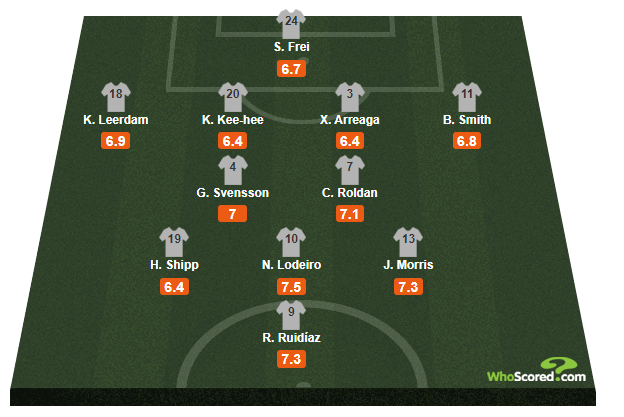
A very interesting find for the Sounders is their attacking over-performance. Throughout the MLS season, the Sounders averaged an expected goal value of 51.35 goals. However, Schmetzer’s team managed to score 63 goals – a differential of 11.65 goals. This was, in the whole league, the biggest over-performance.
As such, one would assume that with the over-performance, the expected value on each shot would perhaps be inflated compared to the average. However, the Sounders have an xG of 0.112 per shot – in perfect alignment with the league average of 0.11.
The Sounders do not take a lot of shots to compensate for their over-performance. Their total shots, over the league, was 457 shots – slightly better than the league average of 447.88. Not only that, their accuracy wasn’t particularly alarming as well.
With 37.9% of their shots being on target, the Sounders were again well within the league average and performed worse than some of their rivals – Toronto FC having 41.5% on target and LA Galaxy having 40% on target.
What is interesting is how their attacking structure plays out to be. 45% – almost half – of all Sounders actions occur in the middle. This is not a surprise considering that the 4-2-3-1 from Schmetzer crowds the middle with a block of five.
However, their attacking structure takes on a lopsided shape with 42% of their attacks coming from the left-hand side. This is reflected in their crosses as the Sounders rank second in crosses, averaging a staggering 348 crosses over the season. This is well above the average of 240.33 crosses and merits a closer look.
With that much play occurring on one side, the possible explanation of Sounder’s lopsided, over-performing, and metric-average attacking statistics may lie on the left side.
Seattle Sounders’ left-hand side key to team’s overperformance
The top five players assisting the Sounders’ goals are all on the left-hand side as well. Nicolás Lodeiro tops the charts with 11 assists to his name. Jordan Morris, Brad Smith, Raúl Ruidíaz, and Cristian Roldan all follow suit with six, five, five, and four assists respectively.
All of these players are located on the left-hand side with the only exception being Lodeiro who plays in the centre. However, a closer look at his heatmap reveals that Lodeiro’s average positions are located in the left-halfspace.
So what are the statistical profiles of these five players that have lifted the Sounders – especially the trio of Lodeiro, Ruidíaz, and Morris? After all, these five players have contributed to 43 goals – 68.2% of their Schmetzer’s team’s seasonal tally. In addition to scoring, the left-hand side has contributed to 31 assists – 68.9% of Sounders’ assists all season.
We’ll first start with Lodeiro as he is the creative fulcrum upon which Sounder’s attack rests upon.
At age 30, the Uruguayan is still an active member of the Sounders and the player that works in the shadows. While the likes of Ruidíaz get a lot of attention, Lodeiro is just as critical if not more.
Despite being initially orientated in the centre of the three-man midfield, Lodeiro’s heatmap shows his affinity to often drift to the left-hand side. This allows Lodeiro to link up Morris and Ruidíaz – the other two creative attackers.
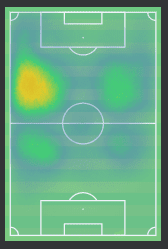
Lodeiro’s role is clearly defined by Schmetzer’s tactics. He is the traditional ‘10’, playing behind the striker and with the support to engage his creative plays. This entails everything from dropping deep to facilitate ball progression – as his heatmap shows – to engaging dribbles and spotting the runs with accurate through-balls.
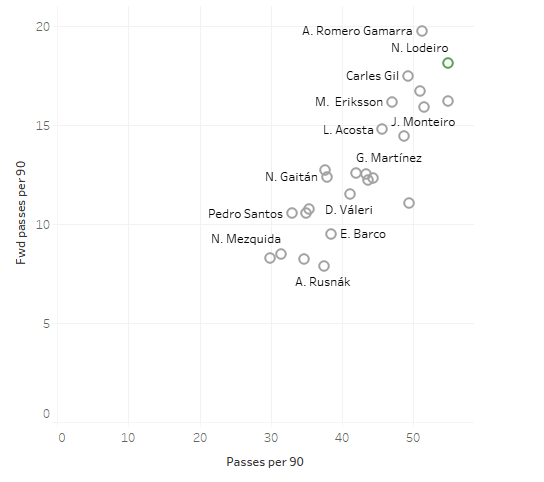
Lodeiro – as expected – is a voluminous passer, making 54.9 passes per 90. This puts him at the apex of passes per 90 for attacking midfielders. However, Lodeiro’s passes do not go lateral or backwards. In fact, Lodeiro is also highly voluminous in making forward passes. Making 18.1 forward passes per 90. Yet again, Lodeiro ranks first in this metric amongst attacking midfielders. Clearly, Lodeiro is one of the best at constantly advancing a team’s vertical play – something crucial in Schmetzer’s team.
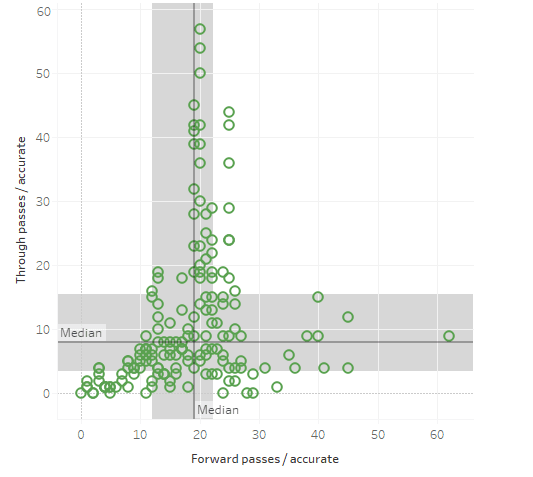
As evidenced by the graph, Lodeiro is a prolific forward passer of the ball, playing anywhere from 10 to 20 accurate forward balls per match. A huge amount of these forward passes end up being accurate through balls – ones that end up breaking the defence and setting the likes of Morris or Ruidíaz free.
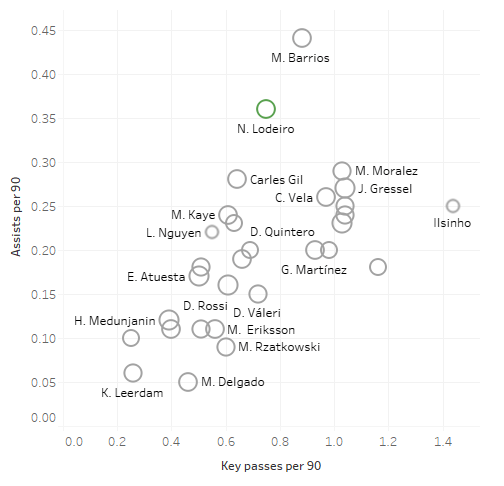
Lodeiro’s creativity is evident with the fact that Lodeiro’s assist per 90 metric one of the highest among all attacking midfielders – as evidenced by the graph. Lodeiro records 0.75 key passes per 90 making him a fairly average key passer. However, the value that he extracts, a metric of 0.36 assists per 90 making him one of the most productive attacking midfielders.
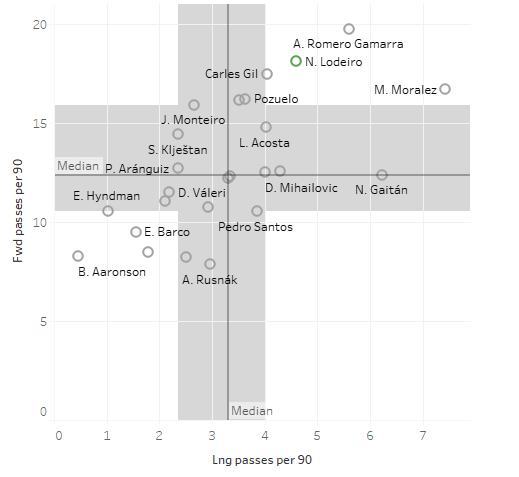
Lodeiro doesn’t limit himself to just short passes and through balls. As evidenced by the graph, Lodeiro is also a highly voluminous long passer. This makes sense as the Sounders often engage in counter-attacks and having someone who can constantly find their runners helps Schmetzer’s attacks. With a production rate of 4.59 long balls per 90, Lodeiro ensures that the midfield has several ways of releasing pressure and creating space.
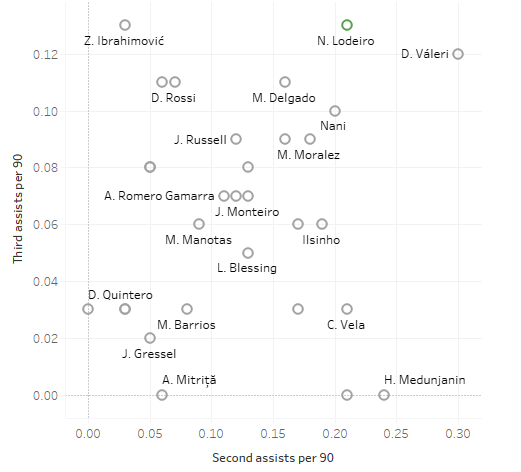
Lodeiro is also highly gifted in interplay and link-up play. As one can see in green, Lodeiro ranks highly in second and third assists per 90 – metrics that measure the involvement of a player before the assist. Clearly, not only does Lodeiro bring his creativity to the table, but he also brings out the creativity in other players.
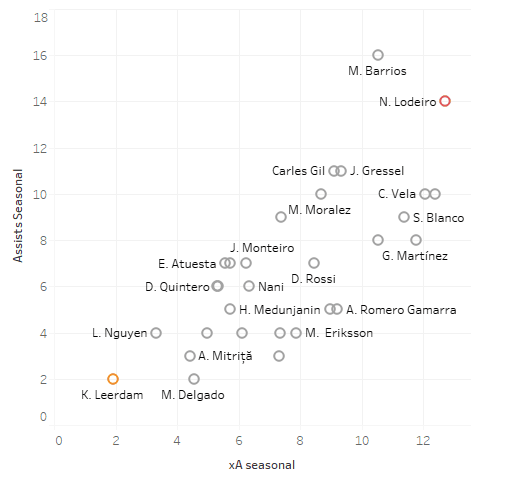
All the creative aspects of Lodeiro result him in having an xA of 12.72 and actually recording an assist record of 14. Lodeiro – in both metrics – is one of the best-attacking players in the league. As such, it is easy to see why Sounders would prefer to play on the left-hand side. It allows Lodeiro to really come into character and play like the talented midfielder he is.
It’s been established, beyond doubt, that the Sounders have, statistically, the best-attacking midfielder in the league. However, beyond creativity and interplay, you need someone who is going to wriggle, fight, and score.
This is where “La Pulga” comes in – Spanish for the flea. So named for his ability to wriggle and turn in tight spaces like a flea, Ruidíaz is one of the Sounders’ best buys to date.
Recording 20 goals and assists, La Pulga is a type of forward that you rarely see. Small in size, he isn’t the traditional forward who will head in the ball or bully his way through hordes. Rather, his technicality, bullish frame, and frame make him one of the most hardworking forwards, constantly running and chasing the defenders.
Another quality that La Pulga has is the ability to receive the ball in very tight spaces or in situations that are numerically disadvantageous to them. He also has an uncanny ability to hold the ball against more bigger defenders.
It is safe to say that Ruidíaz, for good reasons, cemented his place as the go-to striker for the Sounders.
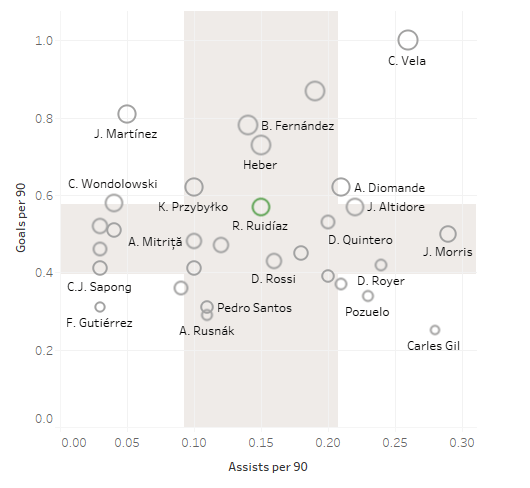
Ruidíaz, in terms of general assists and goals per 90, is averagely placed. As seen in the graphs, Ruidíaz falls in the median range for assists per 90 and goals per 90, averaging 0.15 assists per 90 and 0.57 goals per 90.
While these metrics are not outstanding as those were of Lodeiro, they still speak of a very consistent forward. Other data analyses confirm this.
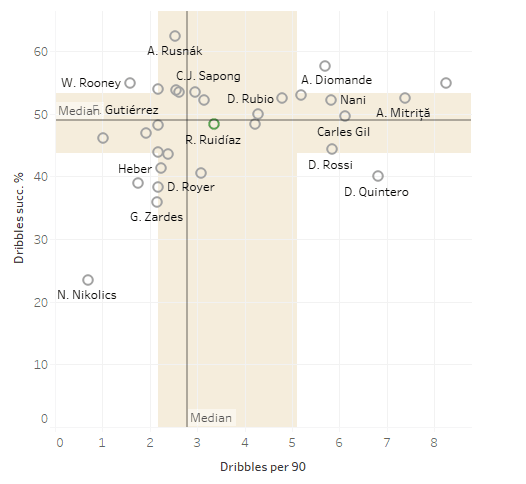
Another key trait of forwards is their ability to do the ‘wriggling’ and ‘twisting’ that so often causes defence problems. In this scenario, Ruidíaz ranks in the median quartile with 3.36 dribbles per 90 but only a success rate of 48.31%
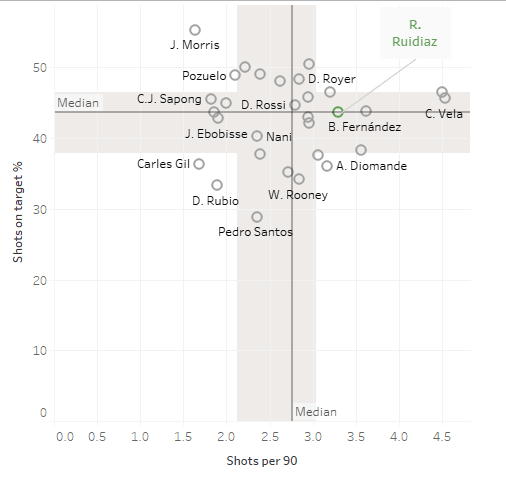
One aspect that Ruidíaz fairly excels is his shots metrics. Averaging 3.29 shots per 90 with an accuracy rate of 43.68%, it shows that Ruidíaz has a high number of shots with a consistent number of them on target. This characteristic is similar to some of the other more successful forwards in the MLS like Carlos Vela who averages 4.54 shots with an accuracy rate of 45.66%
However, the attacking picture doesn’t really close down there. A critical component of the Sounders’ attack was Morris. The American quietly put up 19 goals and assists – similar metrics to that of Lodeiro and Ruidíaz. While his position is in midfield, Morris often ends up playing striker with him and Ruidíaz often switching positions.
So what is Morris good at that contributes to the Sounder’s attack?
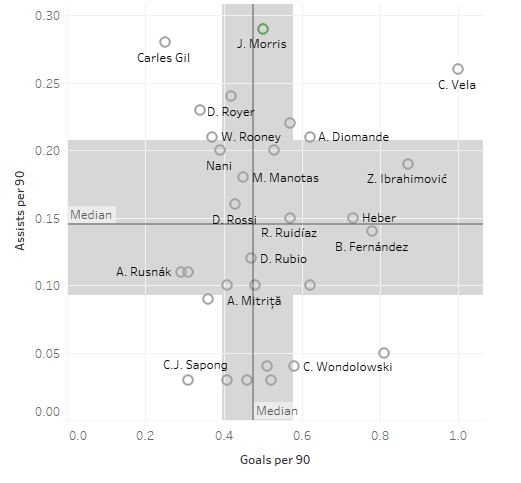
While Morris isn’t that of a prolific goal-scorer, he is certainly a creator – much like Lodeiro. In Morris, Sounders have another creative outlet – one whose numbers are better than the likes of Vela and Diomande. Averaging 0.29 assists per 90 as a forward/attacking midfielder is a great achievement for someone so young to the MLS experience.
However, Morris’ great performances don’t stop there.
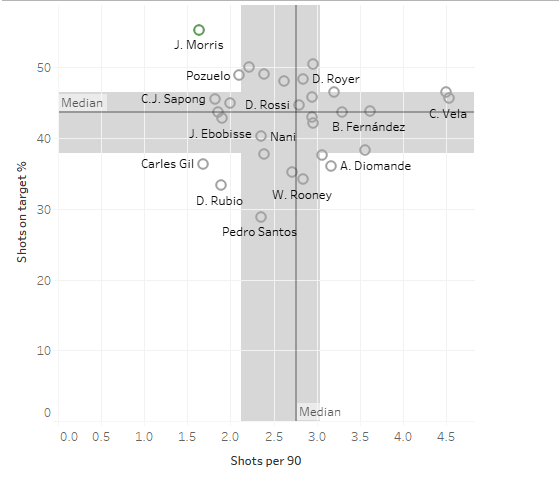
While Morris isn’t a prolific shooter, he is a very accurate one recording an accuracy rate of 55.36% – the highest amongst forwards in the MLS. This fact gives the Sounders an additional attacking force – one that is a sharpshooter.
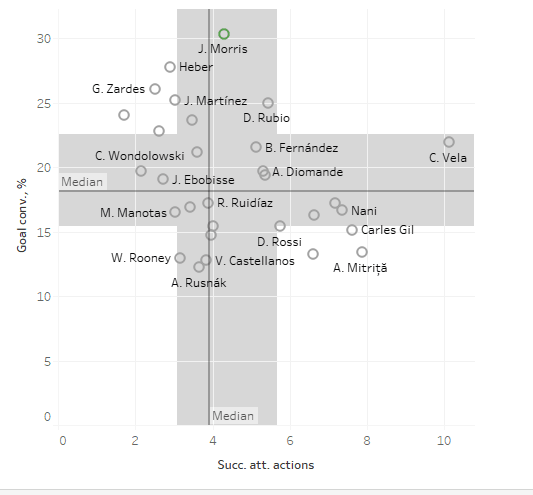
Following the trend, we see how the successful attacking actions translate to goal conversion. Yet again, while Morris does not rank highly in the number of attacking actions, he performs excellently in the goal conversion percentage with a percentage of 30.57% – the highest amongst forwards.
That deviation from the mean is a testament to the amount of attacking prowess Morris brings.
So there you have the attacking trio of Sounders. A creative force that creates space, a consistently hardworking forward, and a sharpshooter of an attacking midfielder. The combination of these three has meant that when the situation demands, the Sounders have been able to respond with grace and power.
Smith and Roldan – the support to the attack
While Morris, Ruidíaz, and Lodeiro carry a lot of the attack, Roldan and Smith also carry important contributions that, while small compared to the big-hitters, are still worth mentioning.
Brad Smith – who is currently on loan to Cardiff City by parent Premier Leauge club Bournemouth – is an attacking full-back that consistently occupies upfield positions and is a solid full-back that adds an element of creativity from the wing.
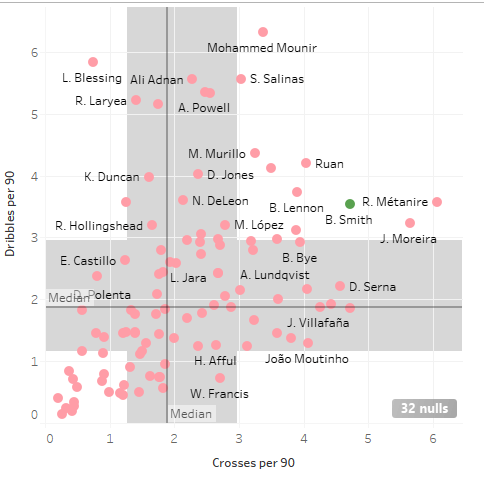
As one can see, Smith is far from the best full-back, however, he puts decent crossing and dribbles per 90 metrics up. On the whole, Smith is a decently good attacking full-back who only enhances Sounders’ attack.
Roldan – on the other hand – serves as a defensive midfielder functioning in the pivot. With 10 goals and assists, Roldan’s purpose is more to add defensive protection – a job that he does good as a midfielder.
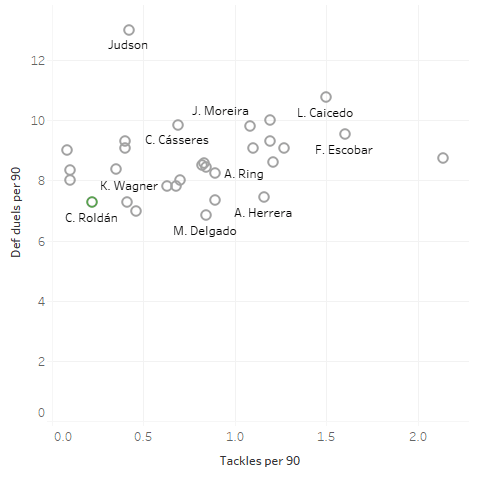
While he isn’t the most prolific tackler for midfielders in the MLS, Roldan does really well in making up that by contributing to a good share of defensive duels.
Both Roldan and Smith are two outliers – one contributing more defensive actions while the other contributing more wing-based actions. However, both work together to add protection to the free-flowing attacking trio ahead of them
Frei reveals deficiencies in Seattle Sounders’ defence
Every good team needs a good goalkeeper and Seattle have in Stefan Frei. The Swiss veteran adds a necessary calmness to the Sounder’s defence and keeps them in games.
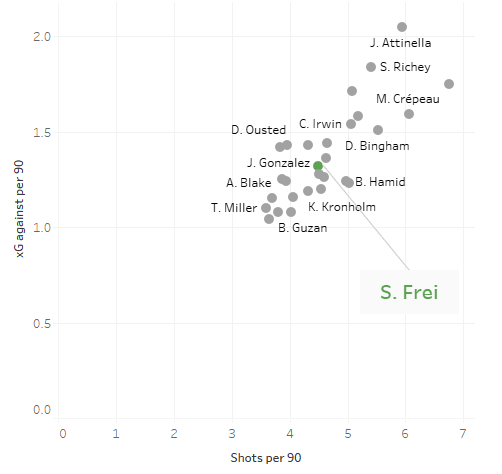
Unlike some of the other goalkeepers, Frei does not receive as many shots per 90. However, when he does, the xG on those shots – accumulated – comes to 1.3 xG. This points to a deficiency in defence of the Sounders. This graph tells us that while the Seattle defence makes the opposition have fewer shots, whenever do they let shots in, their xG is higher.
This xG-shot relationship explains why the Sounders conceded 49 goals – making them the 6th best defence in the Western Conference.
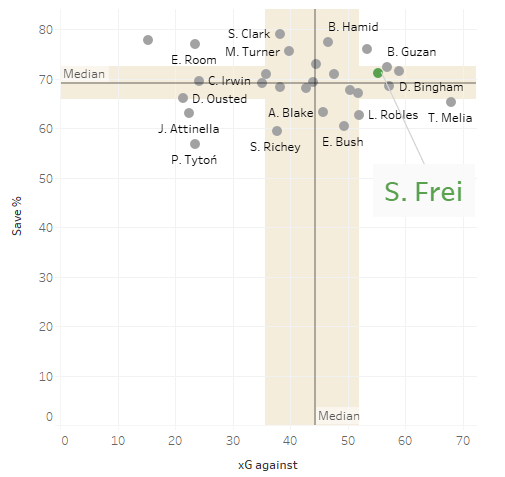
We see the same trend of the Sounders conceding a high number of xG however, we get to see the impact of Frei. His save percentage, around 70%, is an excellent metric that shows just how consistent and impactful Frei’s goalkeeping was for the Sounders.
Conclusion
Through this data analysis, we have seen what factors of the Sounders’ attack made them overperform their xG by such a great amount. A combination of a creative playmaker, a hard-working forward, and a sharpshooter in conjunction with a solid group of players that support them allowed the Sounders to overperform the way they did.
Their defence and attack aren’t the best systematically but the overall way Schmetzer has coached his team meant that they could perform in the high stake scenarios and emerge victorious which is exactly what happened against Toronto FC in the 2019 MLS Cup Finals.





Comments